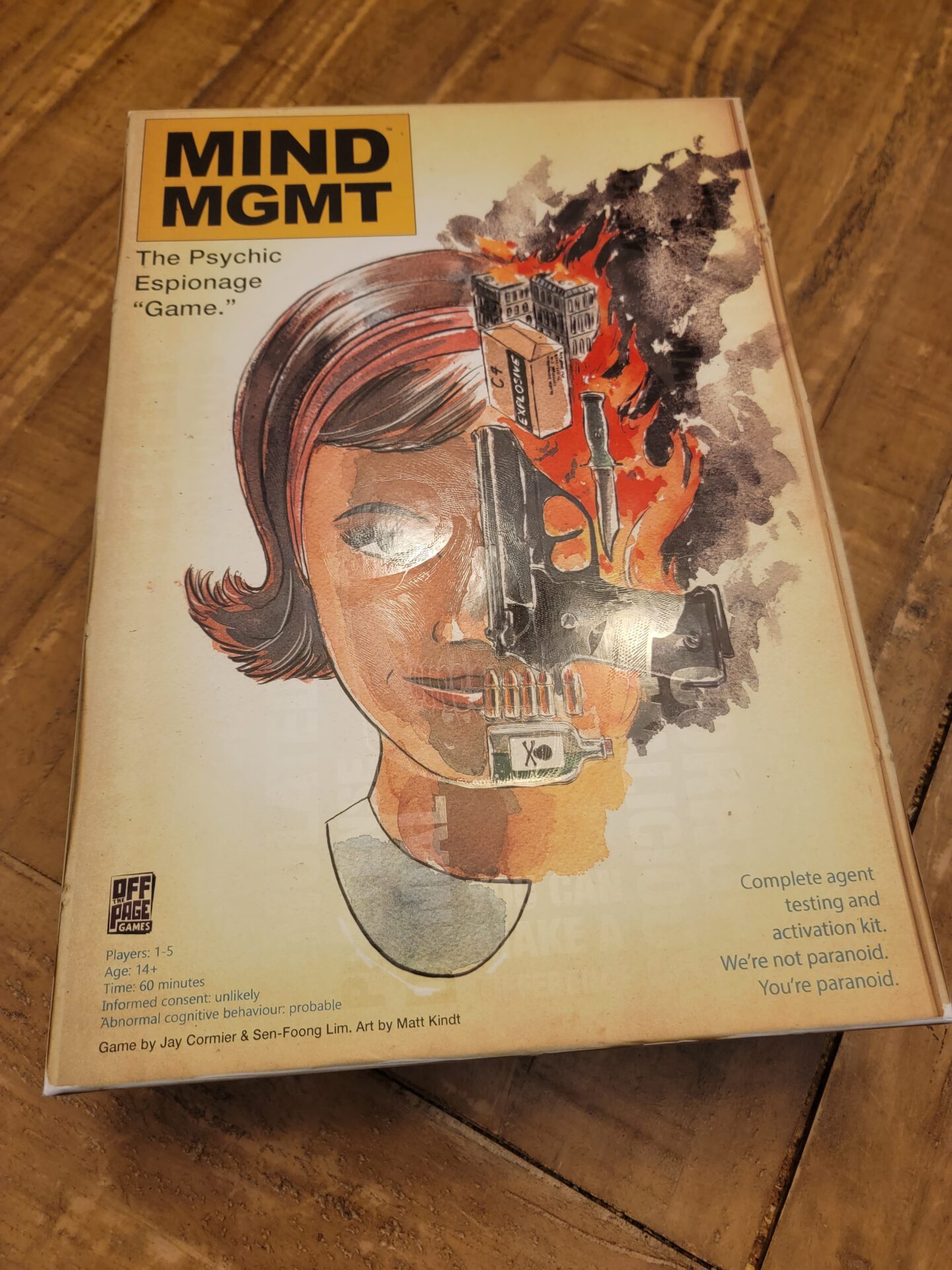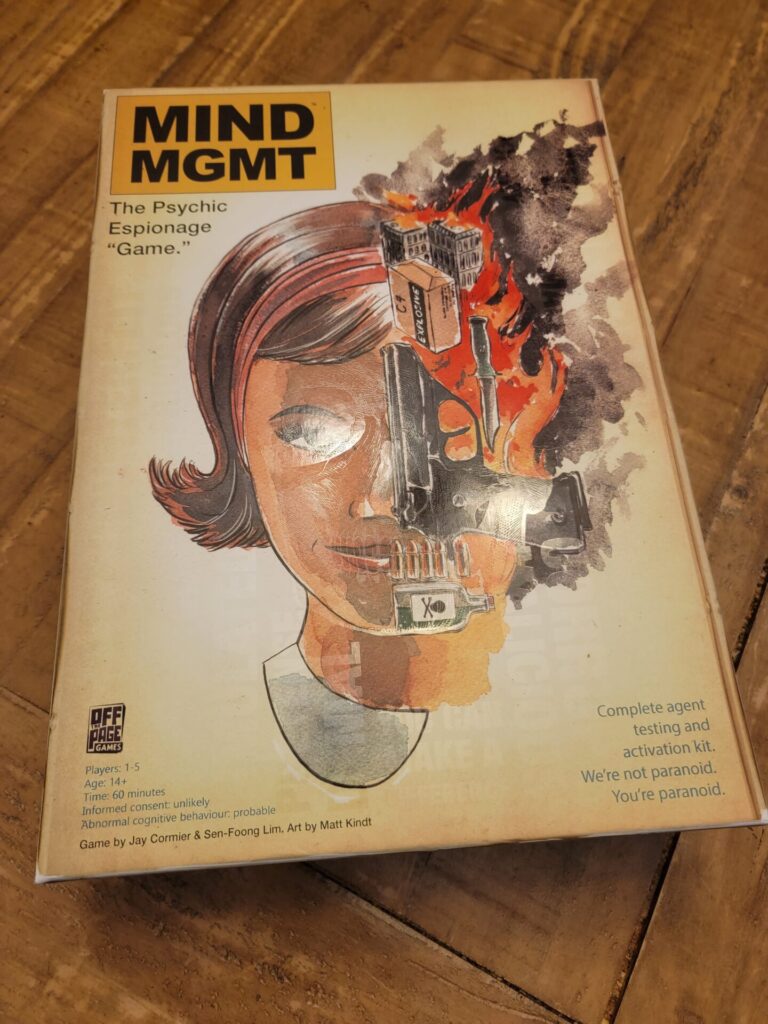
Name: Mind MGMT – The Psychic Espionage “Game”
Year of Release: 2021
Player Count: 1 – 5
Playing Time: 45 – 75 Minutes
Designer: Jay Cormier & Sen-Foong Lim
Publisher: Off the Page Games
Primary Mechanisms: Deduction, Hidden Movement, Paper-and-Pencil, Variable Player Powers
Weight (According to BGG.com): 2.92
Overview
Fortunately, I have a partner who enjoys spending time with me and is OK with a lot of the down time we have together, to be spent playing board games. You’ll notice that I didn’t necessarily say that my partner enjoys board games, but rather, the act of spending time with me. For this reason, a lot of my purchases lately have been predicated on if the game has a solo variant worth the time and money so that my wife doesn’t always feel like she has to play with me when the board gaming mood strikes me (which is to say, all the time.)
Browsing in Barnes & Noble one night, we happened across Mind MGMT. Though I knew almost nothing about this game, I did remember that Mike DiLisio, from Dice Tower, had featured this on his most recent list of “Top 100 Games of All Time.” I remember he was very impressed with both the multiplayer and the solo versions of the game, so I felt pretty good about purchasing this without much more information other than it was a “hidden movement” game and it was based on a graphic novel series of the same name. So, did I end up finding a rare gem of a game, one that is both successful at multiplayer and solo at the same time? Or did Mind MGMT escape, without leaving any trace that it had been here at all?
Rulebook & Components
One of the first things you’ll notice when you glance at the Mind MGMT box is that every inch of the box plays into the theme of the game. The tag line states that Mind MGMT is, in fact, not even a real board game but rather a “psychic espionage ‘game’”. There are scribbles on the box about things not being as they seem as well as those old school red & blue, decoder-needing, lines of text scrawled on every side. The artwork on the box shows a girl’s face, rocking a 60’s haircut, but when moved around to reflect the light, a hidden picture of a skull and other ominous words appear. The whole thing is invocative of the feeling of being caught in a mystery that you have no understanding of, and we haven’t even opened the box yet!
The rulebook continues the trend, written as if it is an instruction manual for a member of the Mind MGMT team, being sent on a critical mission, instead of a rulebook for a board game. Now, I will state that I can see how certain people might find the rulebook hampered by too much of the thematic scribbling and scrawling, as some pages have a lot of text on them. This will probably come down to personal preference and how one best learns to play new games.
Another thing that I want to point out that I really enjoy is that the rulebook allows you to set up a “training game” before moving to the full game. The portions that you need to set out for the training version are clearly delineated from what is needed in the full game. This experience was a real win as we were able to learn about 75% of the normal game, while still playing a rather enjoyable version of the game.
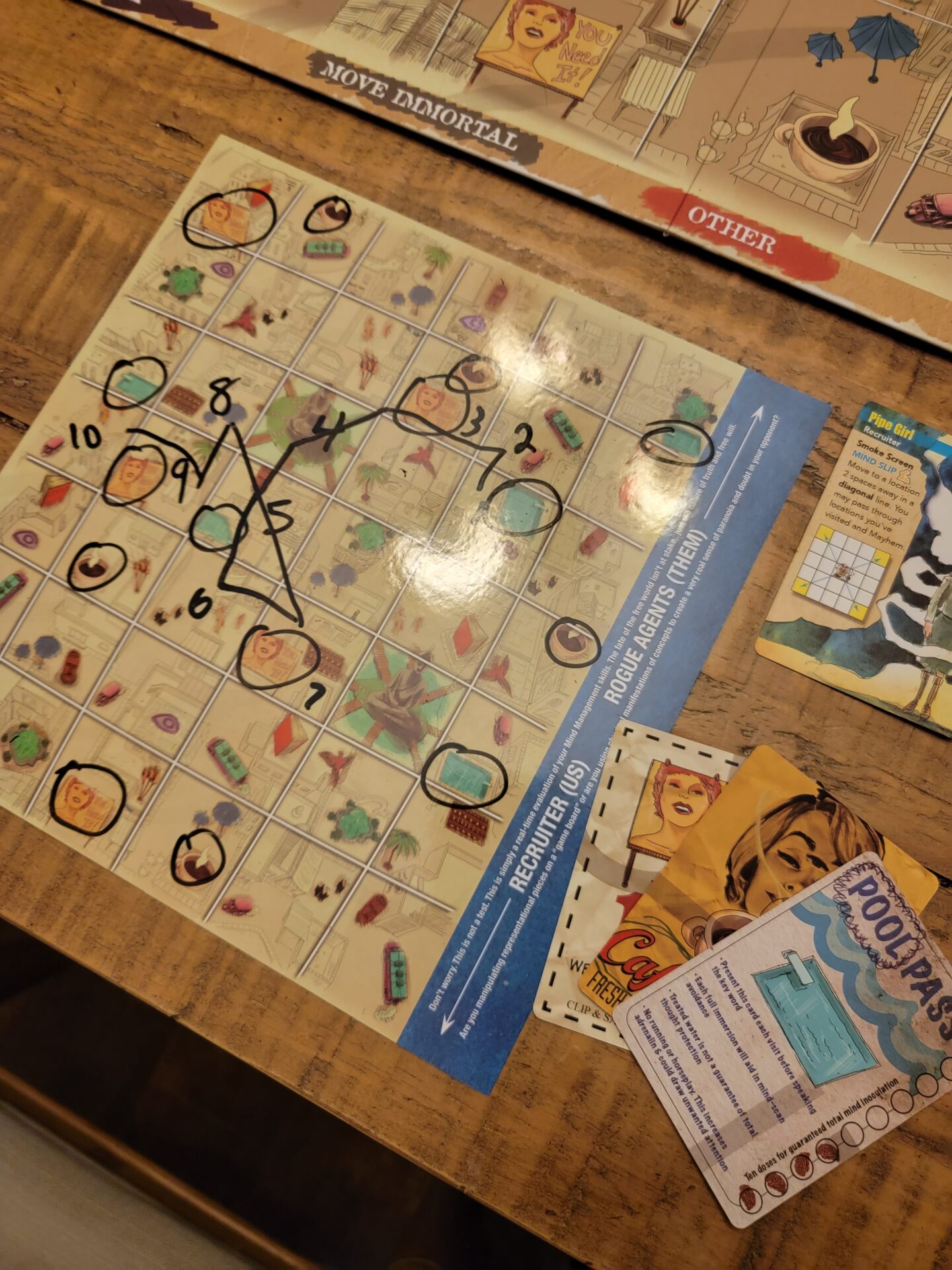
Component-wise, there is a lot packed into this box. The board is a 6×7 grid of the city Zanzibar, populated by a slew of different Features. These Features, 16 in total, are each printed once on an accompanying deck of 16 cards. There is a smaller replica of the map, but in dry-erase format, that the player acting as the Recruiter will utilize. Don’t worry, we’ll discuss more about the Recruiter and it’s opposing role, the Rogue Agents, down in the gameplay section. There is also a slew of cardboard pieces, mainly headshots of different characters that players will be using to move and take action around Zanzibar. The Recruiter’s map isn’t the only dry-erase element in the game though, as you are given 15 double-sided Mental Note Tokens, in the shape of brains, that players can use to make notes on and drop them around the board. All the components tie in perfectly with the theme and are used efficiently throughout the game. The only drawback I’ve seen is that I prefer to take my character figures off of their plastic stands after each game (for storage purposes) but this constant removing of them has started to tear into the cardboard of the figure slightly. I guess I will have to leave them in their stands from now on.
Lastly, I want to just put the words Shift System out there as these are 14 inner boxes that you’ll find at the bottom of the larger game box. These boxes also hold a variety of components (that I won’t be spoiling) but I’d rather touch on this in the gameplay section, so we’ll put a pin in the whole Shift thing for right now.
Setup and Gameplay
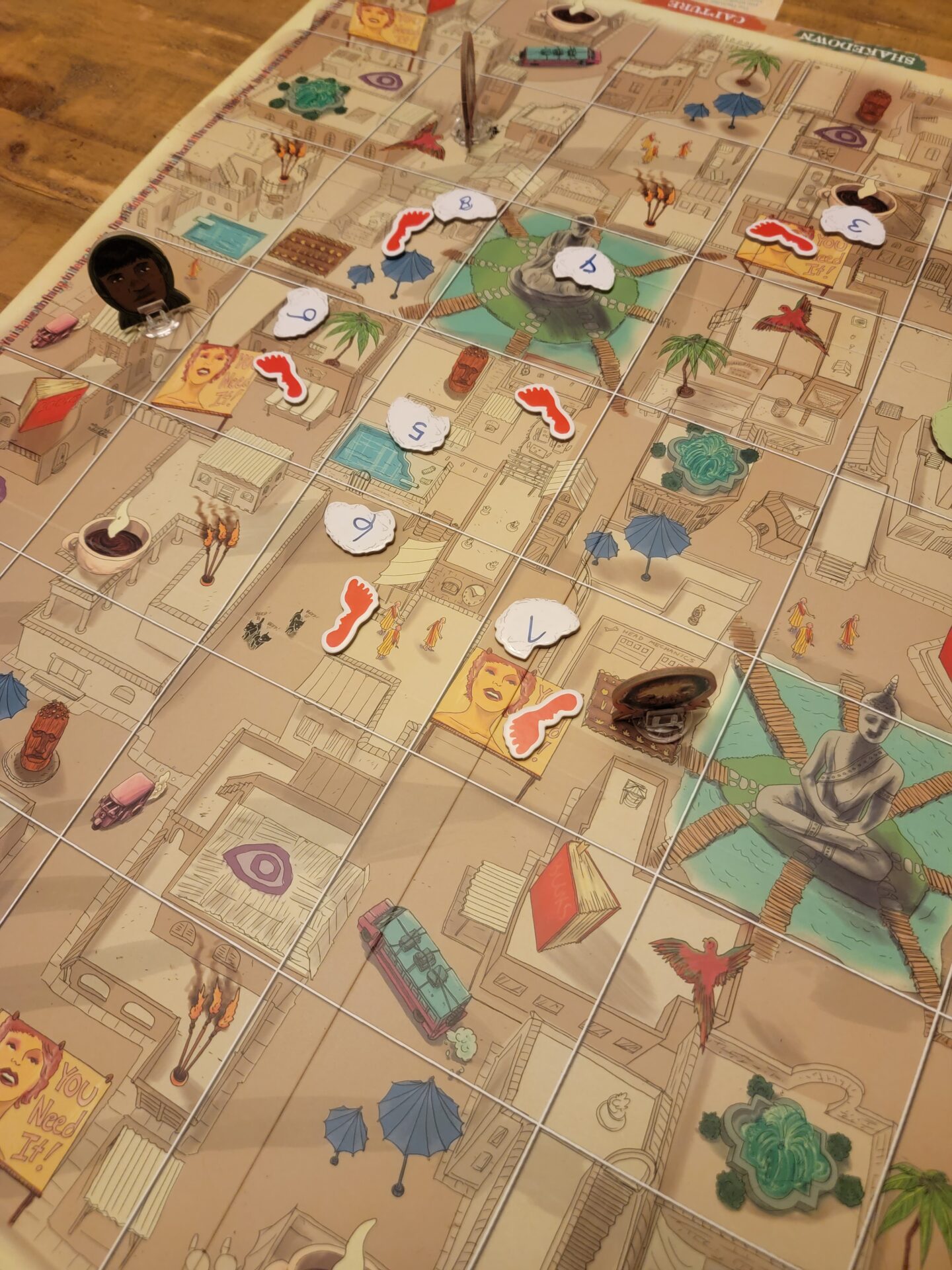
With Mind MGMT being a game that includes a lot of hidden information, setup needs to be done in a specific manner. I won’t go into all of the details here but there is a list that players will follow in order to make sure that setup is completed without any information leaking to the other players. The gist of setup is that the Recruiter is going to draw three Feature cards, in secret, and then circle all the features on their draw erase map. These circles are going to represent the “recruits” that the Recruiter player is attempting to move around the map and collect. The Recruiter will also decide their starting position and then move four additional spaces, so that they are five in-game hours ahead of the Rogue Agents. Lastly, the Recruiter will place out four Immortal Characters, who will end up helping recruit agents as well as helping to block the actions of the Rogue Agents. The player who is acting as the Rogue Agents has a lot less to do during setup. They will put out their four Agent Characters on the main board, ensuring that they follow the one rule of having to be on the edge of the board.
Gameplay occurs over, a possible, ten rounds where Recruiter and Rogue Agents take turns moving the characters on the board. First, the Recruiter will move one step on their dry erase map, ensuring they don’t go back to a spot they’ve already visited and unless they trigger their special action (called a Mind Slip), they must only move in an orthogonal fashion. On the map, the Recruiter will write the number corresponding to the round that they are in. They then move a single Immortal Character on the main board and end their turn by moving the Round Tracking Token up one space.
Play switches to the Rogue Agent player who will now be able to move one Character Token as well as perform one Action such as the Ask Action. When the player takes this action, they are allowed to ask the Recruiter if he/she has visited any certain Feature that the Character Token is currently placed on. If the Recruiter has, they place a Step Token (a red footprint) on one of the grid spaces where they visited where that Feature is found. At this point, the Rogue Agent player doesn’t know exactly when the Recruiter was there, but just that they were. One snag with this action is that any of the Features the Immortal Characters are on will be blocked from being the subject of an Ask Action.
Linked closely with the Ask Action is the Reveal Action. This allows a Rogue Agent to move into a grid with one of the Step Tokens, and then have the Recruiter reveal at which turn they visited that piece of the map. The other main action is the Capture Action which is when the Rogue Agent moves a character into a certain part of the grid, and then asks if the Recruiter is there. If they are, the Rogue Agents win. If not, the game continues moving forward. The Rogue Agent will move and evaluate an action with one character, followed by the other character and then it is the Recruiter’s turn again. Play continues like this until one of the following end-game states are met: a.) the Recruiter finds 12 recruits (meaning they visited a total of 12 circled Features) then the Recruiter wins, b.) the Recruiter is not found before the last round commences at 16:00, then the Recruiter wins, or c.) the Rogue Agents capture the Recruiter before the 16:00 round starts, the Rogue Agents win.
There are a few other twists and turns in the game, such as each Rogue Agent having a different Special Ability, which will add variety within the game. There is also the aforementioned Shift System that attempts to mitigate constant wins by one player. Each time a player loses, they are able to open their role’s next Shift box in sequential order. In general, these boxes add some new ruleset or ability to that side that they can possibly use in future plays. I’ve really enjoyed being surprised by the opening of the boxes and getting to play the game in a variety of ways. While the core game doesn’t change, the Shift System does add some fun ways of evening out the talent gap that might exist between players.
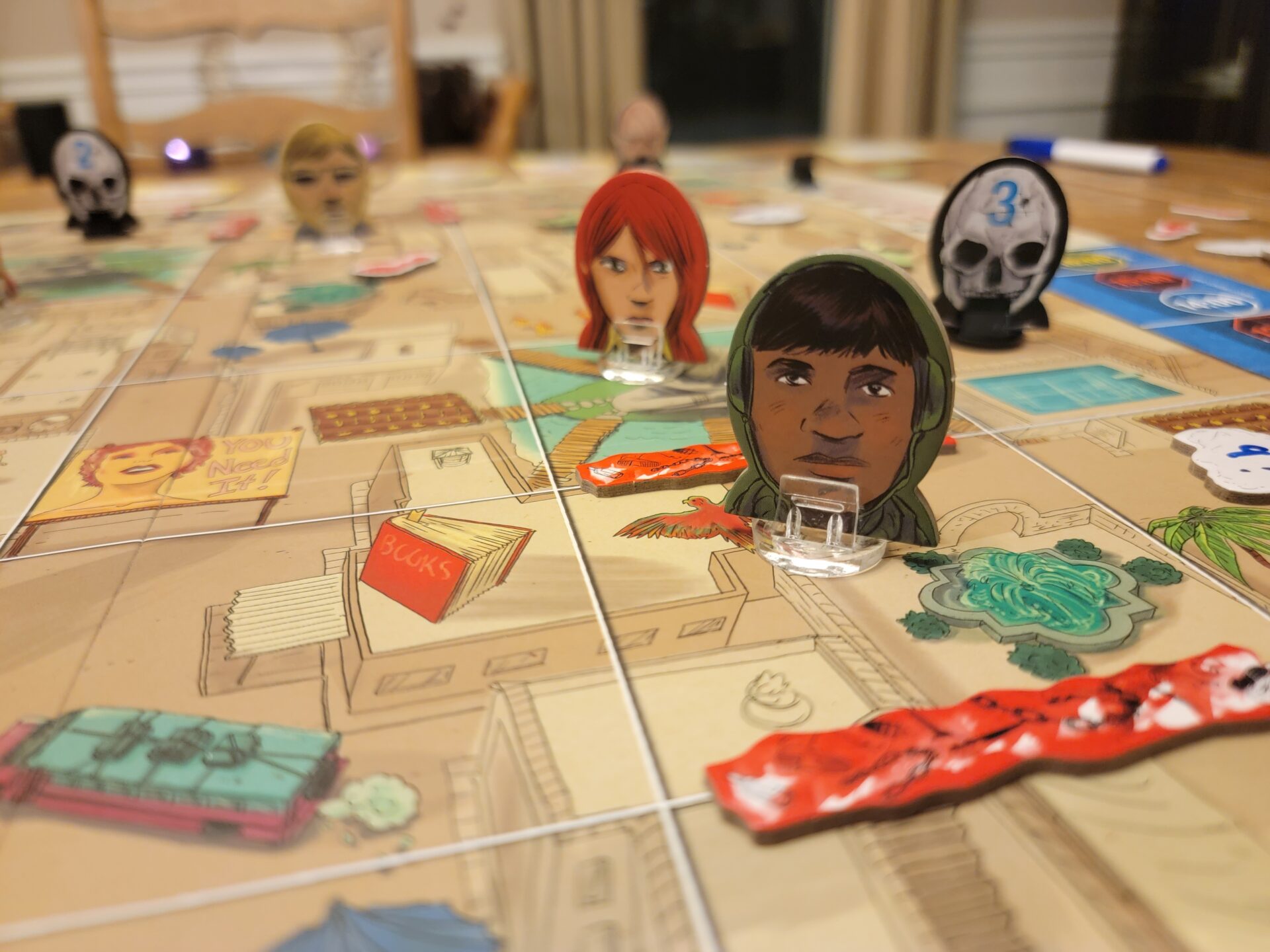
Solo Mode Thoughts
At this point, you might think that I made a typo in the above header because how in the world could this game work in a solo mode? Well, as most answers in the world today are, there’s an app for it! This app is free and will handle the Recruiter side of things. The player will still set up the board in generally the same way but without the dry erase map component. The app will instruct the player where to move the Immortals on the main board and then the player is allowed to move around the Rogue Agents. The player can also take all of the normal actions by “asking” the app about certain Features and Step Tokens. There is even a digital version of the Shift System, where you can add in extra digital components to even out the playing field.
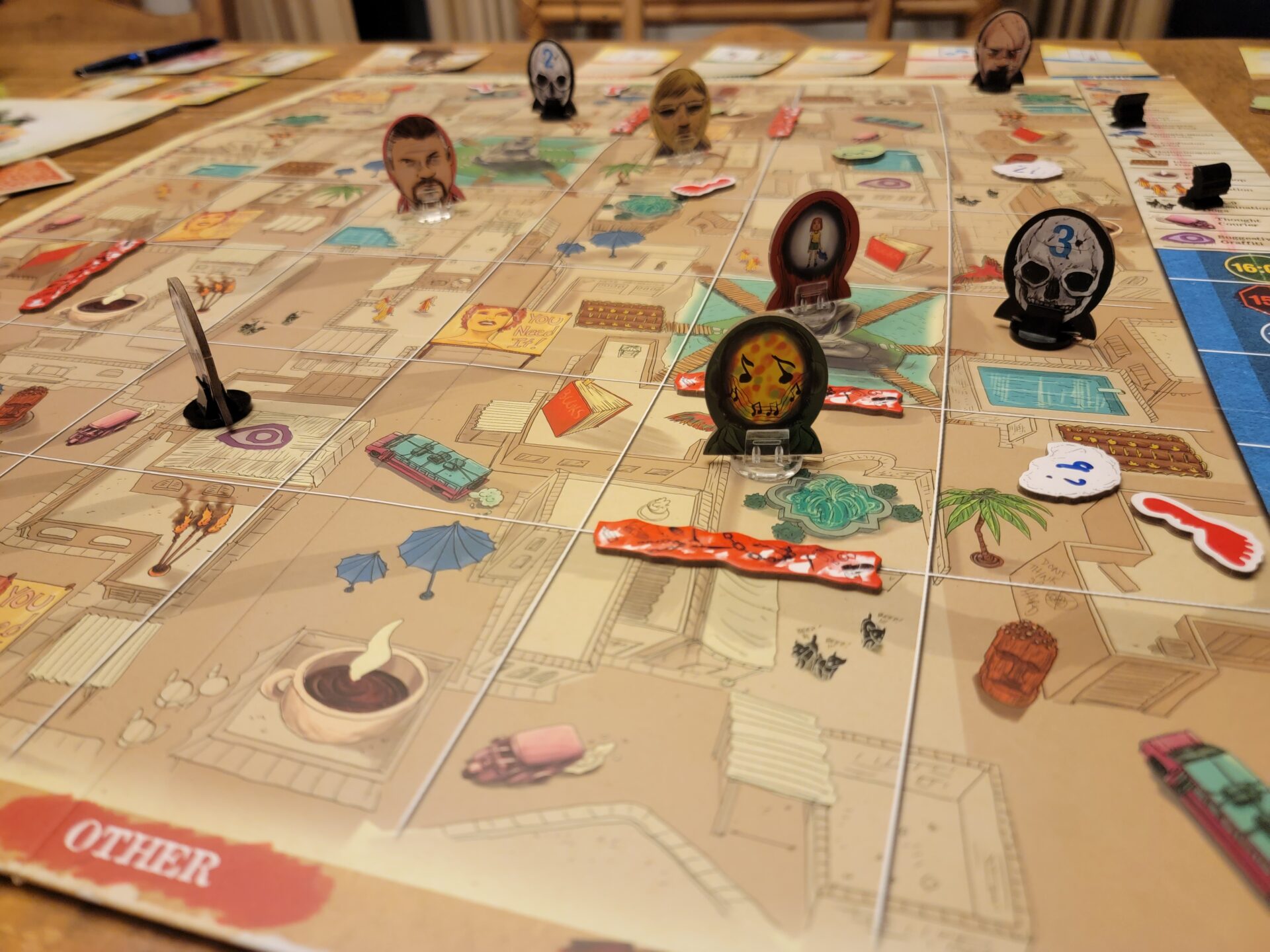
All-in-all, the solo mode is very engaging, if you’re not opposed to having to use an app to make it work. In my experience, you should be ready for a challenge as the app almost always beats me, but if you don’t mind a harder level of difficulty, I believe any fan of the game will find the solo mode intriguing.
Conclusion
Mind MGMT has definitely raised the bar for hidden movement games and has to be considered in the forefront of the genre. From the game’s theme all the way to the innovative Shift System, Mind MGMT is doing everything right.
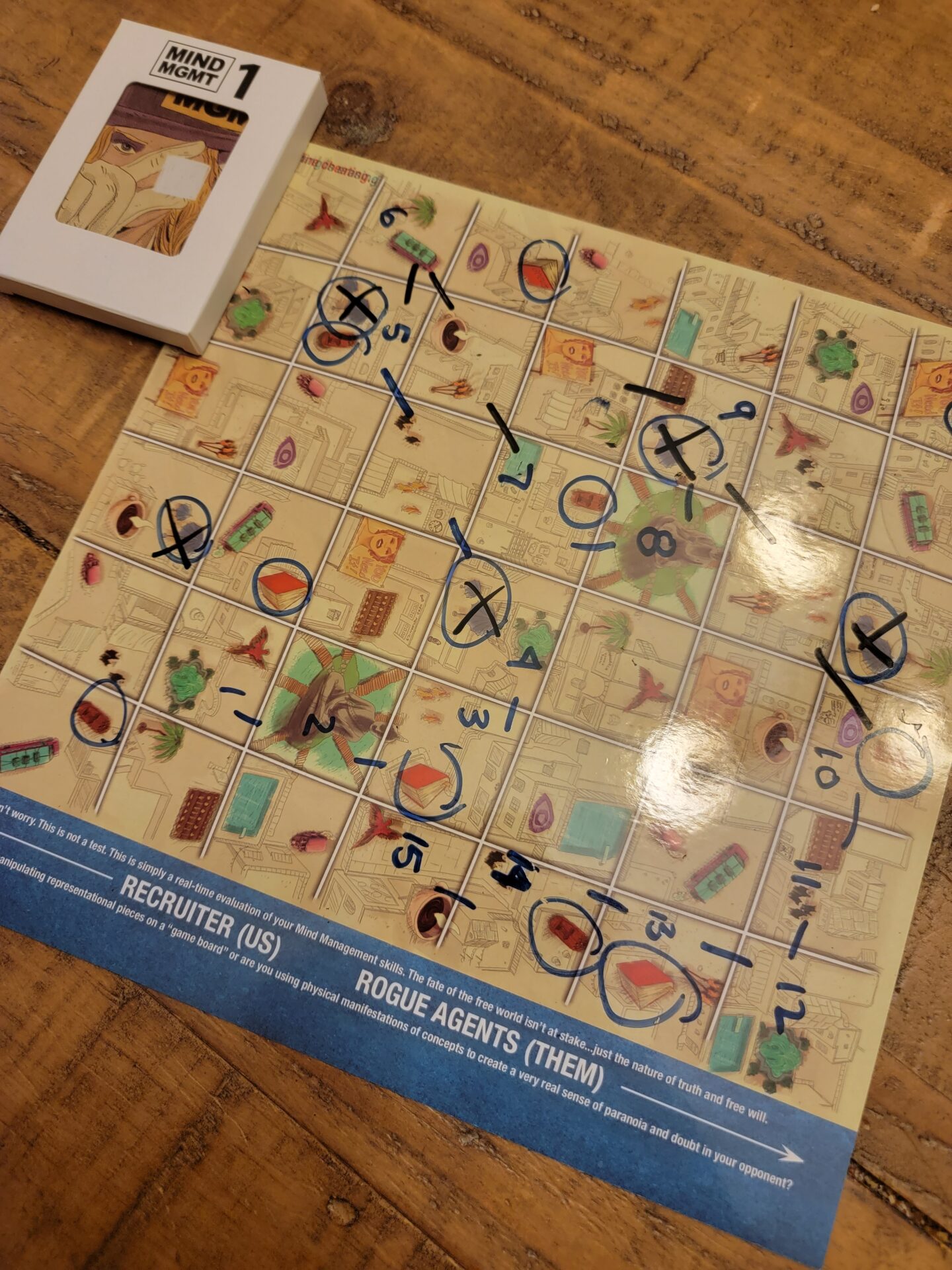
Rating
Ratings are based on 5 main criteria: rulebook, setup, components, art & graphic design, and gameplay. The first 4 criteria are rated 1 to 5 and the gameplay is rated 1 to 10. These scores culminate in an “overall satisfaction” score that is rated from 1 to 10. If the reviewed game has both a solo and multiplayer mode, I have assigned scores separately to give context to which mode we enjoy more.
Links
As an Amazon Associate I earn from qualifying purchases.
Amazon: Amazon.com: Burnt Island Mind MGMT The Psychic Espionage Game : Toys & Games

